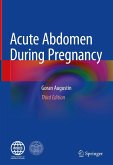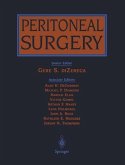Controversies in Acute Pancreatitis (eBook, PDF)
Redaktion: Hollender, L. F.


Alle Infos zum eBook verschenken

Controversies in Acute Pancreatitis (eBook, PDF)
Redaktion: Hollender, L. F.
- Format: PDF
- Merkliste
- Auf die Merkliste
- Bewerten Bewerten
- Teilen
- Produkt teilen
- Produkterinnerung
- Produkterinnerung

Hier können Sie sich einloggen

Bitte loggen Sie sich zunächst in Ihr Kundenkonto ein oder registrieren Sie sich bei bücher.de, um das eBook-Abo tolino select nutzen zu können.
The first complete general study of acute necrotizing hemorrhagic pan creatitis was made in 1889 by Reginald Fitz. If we survey the therapeutic evolution of this severe illness, we may briefly summarize it into three pe riods: (a) resolutely surgical treatment, from approximately 1880 to 1938; (b) much more conservative treatment, from 1938 to 1963; and (c) a return to surgery, from 1963 onward. Hoffmann, in 1911, was probably the first to advocate the removal of the necrotic portion of the pancreas. In 1933, Okinczyc wrote: "The ope rative indications are not a matter for discussion;…mehr
- Geräte: PC
- ohne Kopierschutz
- eBook Hilfe
- Größe: 61.57MB
![Topics in Acute and Chronic Pancreatitis (eBook, PDF) Topics in Acute and Chronic Pancreatitis (eBook, PDF)]() Topics in Acute and Chronic Pancreatitis (eBook, PDF)73,95 €
Topics in Acute and Chronic Pancreatitis (eBook, PDF)73,95 €![Pancreatitis (eBook, PDF) Pancreatitis (eBook, PDF)]() Paul G. LankischPancreatitis (eBook, PDF)73,95 €
Paul G. LankischPancreatitis (eBook, PDF)73,95 €![Acute Abdomen During Pregnancy (eBook, PDF) Acute Abdomen During Pregnancy (eBook, PDF)]() Goran AugustinAcute Abdomen During Pregnancy (eBook, PDF)137,95 €
Goran AugustinAcute Abdomen During Pregnancy (eBook, PDF)137,95 €![Peritoneal Surgery (eBook, PDF) Peritoneal Surgery (eBook, PDF)]() Peritoneal Surgery (eBook, PDF)161,95 €
Peritoneal Surgery (eBook, PDF)161,95 €![Options in the Management of the Open Abdomen (eBook, PDF) Options in the Management of the Open Abdomen (eBook, PDF)]() Options in the Management of the Open Abdomen (eBook, PDF)56,95 €
Options in the Management of the Open Abdomen (eBook, PDF)56,95 €![Pancreatic Disease (eBook, PDF) Pancreatic Disease (eBook, PDF)]() Colin D. JohnsonPancreatic Disease (eBook, PDF)113,95 €
Colin D. JohnsonPancreatic Disease (eBook, PDF)113,95 €![Laparoscopic Ventral Hernia Repair (eBook, PDF) Laparoscopic Ventral Hernia Repair (eBook, PDF)]() Salvador Morales-CondeLaparoscopic Ventral Hernia Repair (eBook, PDF)40,95 €
Salvador Morales-CondeLaparoscopic Ventral Hernia Repair (eBook, PDF)40,95 €-
-
-
Dieser Download kann aus rechtlichen Gründen nur mit Rechnungsadresse in A, B, BG, CY, CZ, D, DK, EW, E, FIN, F, GR, HR, H, IRL, I, LT, L, LR, M, NL, PL, P, R, S, SLO, SK ausgeliefert werden.
- Produktdetails
- Verlag: Springer Berlin Heidelberg
- Seitenzahl: 344
- Erscheinungstermin: 6. Dezember 2012
- Englisch
- ISBN-13: 9783642685187
- Artikelnr.: 53395009
- Verlag: Springer Berlin Heidelberg
- Seitenzahl: 344
- Erscheinungstermin: 6. Dezember 2012
- Englisch
- ISBN-13: 9783642685187
- Artikelnr.: 53395009







